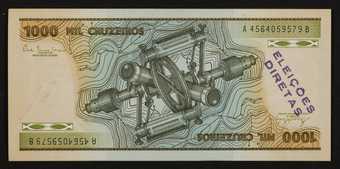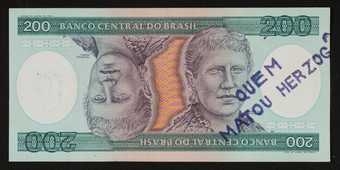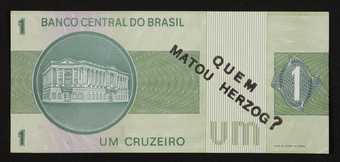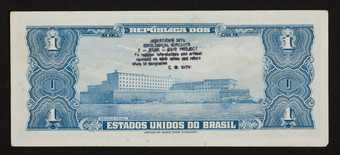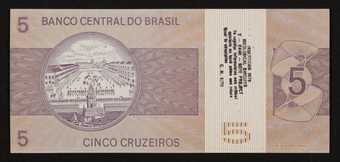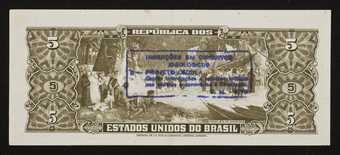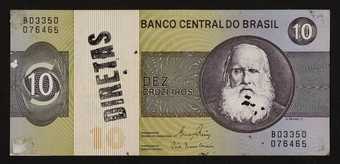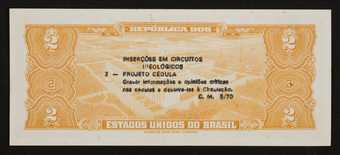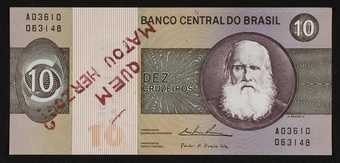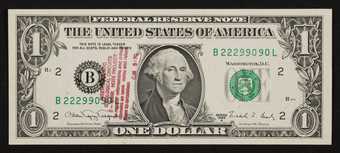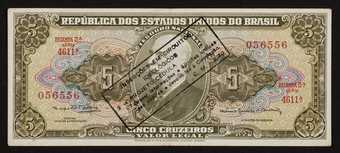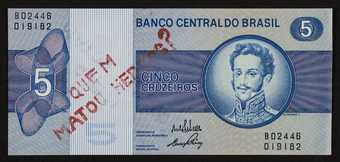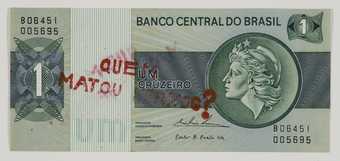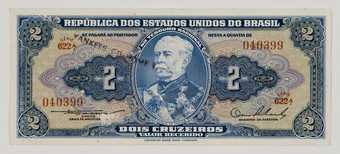Not on display
- Artist
- Cildo Meireles born 1948
- Original title
- Inserções em circuitos ideológicos 2: Projeto Cédula
- Medium
- Ink on banknote
- Dimensions
- Collection
- Tate
- Acquisition
- Presented by the artist 2006, accessioned 2008
- Reference
- T12531
Summary
Meireles conceived his two Insertions into Ideological Circuits projects for an exhibition of conceptual art held at The Museum of Modern Art, New York in 1970 entitled Information. The Cédula or Banknote Project and the Coca-Cola Project (see Tate T12328) explore the notion of circulation and exchange of goods, wealth and information as manifestations of the dominant ideology. For the Banknote Project Meireles stamped subversive messages onto banknotes before returning them to normal circulation. The twenty-seven banknotes presented to Tate by the artist include varying denominations of cruzeiro notes – the Brazilian currency of the time – as well as US dollar bills. The messages, appearing in both English and Portuguese, include such anti-American slogans as ‘Yankees Go Home’ as well as calls for democracy and political freedom – ‘Straight Elections’ – and the words ‘Quem Matou Herzog?’ or ‘Who Killed Herzog?’, referring to a journalist who died in police custody under suspicious circumstances. Meireles stamped the banknotes on both sides – his message appearing on one side and the work’s title and the artist’s statement of purpose: ‘To register informations and critical opinions on bottles and return them to circulation’ – appearing on the other. The Coca-Cola Project follows a similar format: Meireles attached transparent labels with his slogans and the work’s title and purpose to the sides of Coca-Cola bottles which, once emptied of Coca-Cola, would be returned to the factory to be reused. Thus the artist’s messages circulated invisibly within Brazilian society. Meireles has commented:
The Insertions into Ideological Circuits arose out of the need to create a system for the circulation and exchange of information that did not depend on any kind of centralized control. This would be a form of language, a system essentially opposed to the media of press, radio and television – typical examples of media that actually reach an enormous audience, but in the circulation systems of which there is always a degree of control and channelling of the information inserted ... The way I conceived it, the Insertions would only exist to the extent that they ceased to be the work of just one person. The work only exists to the extent that other people participate in it. What also arises is the need for anonymity. By extension, the question of anonymity involves the question of ownership. When the object of art becomes a practice, it becomes something over which you can have no control or ownership.
(Quoted in Cameron, pp.110-12.)
In 1970, when Meireles produced the Insertions into Ideological Circuits projects, Brazil was undergoing the most oppressive period of its twenty-one year government by military dictatorship. At the time, the Insertions constituted a form of guerrilla tactics of political resistance in order to elude the strict state censorship enforced by the regime. For Meireles, the texts on circulating bottles and banknotes ‘functioned as a kind of mobile grafitti’ (quoted in Cameron, p.13). The stamped banknotes presented to Tate by the artist are symbols of the work which, for Meireles, is only operating when the notes are actually in circulation. In the case of the cruzeiro notes, their status as relics is enhanced by the fact that the cruzeiro is no longer legal tender: it was replaced, first by the cruzado in 1986 and, after a brief period of reinstatement from 1990-93, by the real in 1994. Meireles’s process of rubber stamping banknotes imitates the method adopted by the Brazilian Central Bank to upgrade the old cruzeiro to a new cruzeiro (literally called the cruzeiro novo) in 1967: old banknotes were revalued with a simple handstamp, dividing their value by one thousand. The Banknote Project has never been sold because the artist’s intention is that people may stamp their own messages on banknotes and themselves send out views or commentary into wider circulation. This may be done in any country, with any currency.
Meireles belongs to a generation of Brazilian artists who fuse conceptual thinking with a multisensorial approach that prioritises the body. Labelled Neo-Concretism, the movement was founded in the late 1950s by Lygia Clark (1920-88) and Lydia Pape (1929-2004) and extended in the 1960s to include Hélio Oiticica (1937-80). In his objects and installations, Meireles uses a range of strategies to engage the viewer as a participant in the work. The Insertions into Ideological Circuits projects go beyond the viewer in the gallery or museum, and extend to a wider public who may be unaware of their contact with art.
Further reading:
Open Systems: Rethinking Art c.1970, exhibition catalogue, Tate Modern, London 2005, reproduced fig.54 p.139 in colour.
Information, exhibition catalogue, Museum of Modern Art, New York 1970.
Dan Cameron, Paulo Herkenhoff and Gerardo Mosquera, Cildo Meireles, London 1999, pp.108-16, reproduced pp.112-14 in colour.
Elizabeth Manchester
September 2006
Does this text contain inaccurate information or language that you feel we should improve or change? We would like to hear from you.
Display caption
Meireles started this project during the military dictatorship in Brazil. In the face of strict state censorship he stamped messages calling for democracy and political freedom on banknotes and returned them into circulation. This work relates The Coca-Cola Project. The artist is happy for others to participate in this project, stamping their own messages on the banknotes of any country. For Meireles, the notes displayed here are only documentation. The work operates when the notes are used as currency.
Gallery label, August 2020
Does this text contain inaccurate information or language that you feel we should improve or change? We would like to hear from you.
Explore
- abstraction(8,615)
-
- non-representational(6,161)
-
- text(1,043)
- formal qualities(12,454)
-
- defacement(257)
- miscellaneous(732)
-
- money(254)
- government and politics(3,355)
-
- political prisoner(68)
- political protest(361)
- totalitarianism(139)
- censorship(50)
- commerce(93)
- corruption(117)
- persecution(89)
- inscriptions(6,664)
-
- printed text(1,138)
You might like
-
Cildo Meireles Insertions into Ideological Circuits 2: Banknote Project
1970 -
Cildo Meireles Insertions into Ideological Circuits 2: Banknote Project
1970 -
Cildo Meireles Insertions into Ideological Circuits 2: Banknote Project
1970 -
Cildo Meireles Insertions into Ideological Circuits 2: Banknote Project
1970 -
Cildo Meireles Insertions into Ideological Circuits 2: Banknote Project
1970 -
Cildo Meireles Insertions into Ideological Circuits 2: Banknote Project
1970 -
Cildo Meireles Insertions into Ideological Circuits 2: Banknote Project
1970 -
Cildo Meireles Insertions into Ideological Circuits 2: Banknote Project
1970 -
Cildo Meireles Insertions into Ideological Circuits 2: Banknote Project
1970 -
Cildo Meireles Insertions into Ideological Circuits 2: Banknote Project
1970 -
Cildo Meireles Insertions into Ideological Circuits 2: Banknote Project
1970 -
Cildo Meireles Insertions into Ideological Circuits 2: Banknote Project
1970 -
Cildo Meireles Insertions into Ideological Circuits 2: Banknote Project
1970 -
Cildo Meireles Insertions into Ideological Circuits 2: Banknote Project
1970 -
Cildo Meireles Insertions into Ideological Circuits 2: Banknote Project
1970


